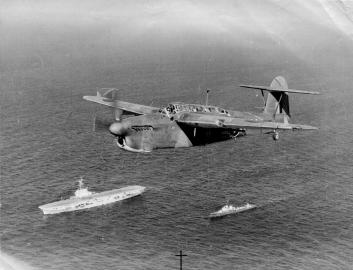Reconstruction of Second World War Barracuda DP872 aircraft gets funding boost from descendants of rear gunner lost at sea
- View news filtered by: Museum Story
- View news filtered by: Ships and Aircraft
- View news filtered by: Aircraft
- View news filtered by type: Press Release

In the Second World War more than 2500 Fairey Barracudas were delivered to the Fleet Air Arm, making it one of the most widely used by the Royal Navy at that time. Unlike some of its better-known counterparts there is not a single intact Barracuda remaining today.
Since the 1970s a remarkable project has been underway - a labour of love and dedication led by the team at The National Museum of the Royal Navy’s Yeovilton-based Fleet Air Arm Museum.
Their ambitious mission is to reconstruct a complete (non-flying) Barracuda aircraft.
Piece by piece, a passionate team of staff and volunteers at the museum has been given Ministry of Defence (MOD) permission to gather scattered parts from wreck sites across the British Isles. Their unwavering commitment is driven by a desire to not just preserve the aircraft but also to honour the courageous individuals who built, flew and maintained them.
The first major milestone was recovering components such as the nose, centre section and wing parts from Barracuda DP872 - essential building blocks for this restoration project. This has included the underwater excavation of an aircraft by Wessex Archaeology from the Solent in 2019.
'Barracuda Live: The Big Rebuild,' is a long-term project which will employ a delicate balance of reclaimed original parts and newly manufactured components. Wherever possible, authentic Barracuda parts are extracted from wreck sites and subjected to a rigorous conservation process to stabilise and de-corrode them, preserving their historical significance.
The project now has a new home in the museum - the Arthur Kimberley Viewing Gallery. The gallery is a testament to the remarkable journey of Arthur Kimberley, a Telegraphist Air Gunner who flew in Barracuda aircraft attached to 827 Naval Air Squadron during Arctic Convoy duties. At just 20-years-old, Kimberley tragically lost his life during an anti-submarine patrol amid treacherous North Sea weather conditions when his aircraft vanished without a trace after take-off.
Thanks to the generosity of his descendants, the Burge family, this project has received a much-needed boost, returning it to the public domain and allowing visitors to witness first-hand the painstaking work carried out by the National Museum of the Royal Navy’s conservation team.
Diana Davies, Head of Conservation at The National Museum of the Royal Navy said:
"The Barracuda Rebuild project will complete our Fairey aircraft collection and fill a significant gap in the collection, but it is about much more than resurrecting an extinct aircraft.
The technical skills and knowledge of the conservation team are outstanding and expanding all the time when working with this material. The conservation of these wrecks is revealing so much information that cannot be found anywhere else except on the physical remains of the aircraft themselves. We want to use all this information to engage with the people who flew and operated Barracudas, their families, and anyone who has an interest, to tell all strands of the story and connect with our audiences on all levels – archaeological, technical and emotional.
I can’t think of anyone else attempting this anywhere else – people do build aircraft and vintage ones of course, but not from archaeological wreckage!"
'Barracuda Live: The Big Rebuild,' opens to visitors from Friday 22nd September and the experience is included with a valid museum ticket.